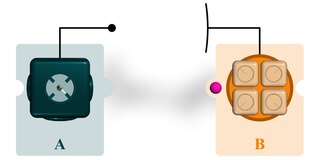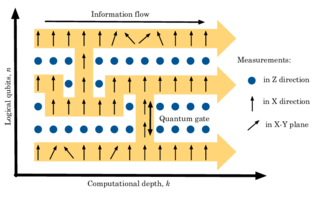In physics, the no-cloning theorem states that it is impossible to create an independent and identical copy of an arbitrary unknown quantum state, a statement which has profound implications in the field of quantum computing among others. The theorem is an evolution of the 1970 no-go theorem authored by James Park, in which he demonstrates that a non-disturbing measurement scheme which is both simple and perfect cannot exist. The aforementioned theorems do not preclude the state of one system becoming entangled with the state of another as cloning specifically refers to the creation of a separable state with identical factors. For example, one might use the controlled NOT gate and the Walsh–Hadamard gate to entangle two qubits without violating the no-cloning theorem as no well-defined state may be defined in terms of a subsystem of an entangled state. The no-cloning theorem concerns only pure states whereas the generalized statement regarding mixed states is known as the no-broadcast theorem.

Quantum teleportation is a technique for transferring quantum information from a sender at one location to a receiver some distance away. While teleportation is commonly portrayed in science fiction as a means to transfer physical objects from one location to the next, quantum teleportation only transfers quantum information. The sender does not have to know the particular quantum state being transferred. Moreover, the location of the recipient can be unknown, but to complete the quantum teleportation, classical information needs to be sent from sender to receiver. Because classical information needs to be sent, quantum teleportation cannot occur faster than the speed of light.

In quantum computing, a qubit or quantum bit is a basic unit of quantum information—the quantum version of the classic binary bit physically realized with a two-state device. A qubit is a two-state quantum-mechanical system, one of the simplest quantum systems displaying the peculiarity of quantum mechanics. Examples include the spin of the electron in which the two levels can be taken as spin up and spin down; or the polarization of a single photon in which the two spin states can also be measured as horizontal and vertical linear polarization. In a classical system, a bit would have to be in one state or the other. However, quantum mechanics allows the qubit to be in a coherent superposition of multiple states simultaneously, a property that is fundamental to quantum mechanics and quantum computing.
In physics, the CHSH inequality can be used in the proof of Bell's theorem, which states that certain consequences of entanglement in quantum mechanics cannot be reproduced by local hidden-variable theories. Experimental verification of the inequality being violated is seen as confirmation that nature cannot be described by such theories. CHSH stands for John Clauser, Michael Horne, Abner Shimony, and Richard Holt, who described it in a much-cited paper published in 1969. They derived the CHSH inequality, which, as with John Stewart Bell's original inequality, is a constraint—on the statistical occurrence of "coincidences" in a Bell test—which is necessarily true if an underlying local hidden-variable theory exists. In practice, the inequality is routinely violated by modern experiments in quantum mechanics.
In quantum computing and specifically the quantum circuit model of computation, a quantum logic gate is a basic quantum circuit operating on a small number of qubits. Quantum logic gates are the building blocks of quantum circuits, like classical logic gates are for conventional digital circuits.
In quantum information science, the Bell's states or EPR pairs are specific quantum states of two qubits that represent the simplest examples of quantum entanglement. The Bell's states are a form of entangled and normalized basis vectors. This normalization implies that the overall probability of the particle being in one of the mentioned states is 1: . Entanglement is a basis-independent result of superposition. Due to this superposition, measurement of the qubit will "collapse" it into one of its basis states with a given probability. Because of the entanglement, measurement of one qubit will "collapse" the other qubit to a state whose measurement will yield one of two possible values, where the value depends on which Bell's state the two qubits are in initially. Bell's states can be generalized to certain quantum states of multi-qubit systems, such as the GHZ state for three or more subsystems.
In quantum information theory, a quantum channel is a communication channel which can transmit quantum information, as well as classical information. An example of quantum information is the state of a qubit. An example of classical information is a text document transmitted over the Internet.

In computer science, the controlled NOT gate, controlled-X gate, controlled-bit-flip gate, Feynman gate or controlled Pauli-X is a quantum logic gate that is an essential component in the construction of a gate-based quantum computer. It can be used to entangle and disentangle Bell states. Any quantum circuit can be simulated to an arbitrary degree of accuracy using a combination of CNOT gates and single qubit rotations. The gate is sometimes named after Richard Feynman who developed an early notation for quantum gate diagrams in 1986.

LOCC, or local operations and classical communication, is a method in quantum information theory where a local (product) operation is performed on part of the system, and where the result of that operation is "communicated" classically to another part where usually another local operation is performed conditioned on the information received.

In physics, in the area of quantum information theory, a Greenberger–Horne–Zeilinger state is a certain type of entangled quantum state that involves at least three subsystems. The four-particle version was first studied by Daniel Greenberger, Michael Horne and Anton Zeilinger in 1989, and the three-particle version was introduced by N. David Mermin in 1990. Extremely non-classical properties of the state have been observed. GHZ states for large numbers of qubits are theorized to give enhanced performance for metrology compared to other qubit superposition states.

The one-way or measurement-based quantum computer (MBQC) is a method of quantum computing that first prepares an entangled resource state, usually a cluster state or graph state, then performs single qubit measurements on it. It is "one-way" because the resource state is destroyed by the measurements.
Quantum pseudo-telepathy describes the use of quantum entanglement to eliminate the need for classical communications. A nonlocal game is said to display quantum pseudo-telepathy if players who can use entanglement can win it with certainty while players without it can not. The prefix pseudo refers to the fact that quantum pseudo-telepathy does not involve the exchange of information between any parties. Instead, quantum pseudo-telepathy removes the need for parties to exchange information in some circumstances.
Entanglement distillation is the transformation of N copies of an arbitrary entangled state into some number of approximately pure Bell pairs, using only local operations and classical communication.
In quantum computing, the quantum Fourier transform (QFT) is a linear transformation on quantum bits, and is the quantum analogue of the discrete Fourier transform. The quantum Fourier transform is a part of many quantum algorithms, notably Shor's algorithm for factoring and computing the discrete logarithm, the quantum phase estimation algorithm for estimating the eigenvalues of a unitary operator, and algorithms for the hidden subgroup problem. The quantum Fourier transform was discovered by Don Coppersmith.

Quantum complex networks are complex networks whose nodes are quantum computing devices. Quantum mechanics has been used to create secure quantum communications channels that are protected from hacking. Quantum communications offer the potential for secure enterprise-scale solutions.
Consider two remote players, connected by a channel, that don't trust each other. The problem of them agreeing on a random bit by exchanging messages over this channel, without relying on any trusted third party, is called the coin flipping problem in cryptography. Quantum coin flipping uses the principles of quantum mechanics to encrypt messages for secure communication. It is a cryptographic primitive which can be used to construct more complex and useful cryptographic protocols, e.g. Quantum Byzantine agreement.
Optical cluster states are a proposed tool to achieve quantum computational universality in linear optical quantum computing (LOQC). As direct entangling operations with photons often require nonlinear effects, probabilistic generation of entangled resource states has been proposed as an alternative path to the direct approach.
In quantum physics, the "monogamy" of quantum entanglement refers to the fundamental property that it cannot be freely shared between arbitrarily many parties.
Parity measurement is a procedure in quantum information science used for error detection in quantum qubits. A parity measurement checks the equality of two qubits to return a true or false answer, which can be used to determine whether a correction needs to occur. Additional measurements can be made for a system greater than two qubits. Because parity measurement does not measure the state of singular bits but rather gets information about the whole state, it is considered an example of a joint measurement. Joint measurements do not have the consequence of destroying the original state of a qubit as normal quantum measurements do. Mathematically speaking, parity measurements are used to project a state into an eigenstate of an operator and to acquire its eigenvalue.















































